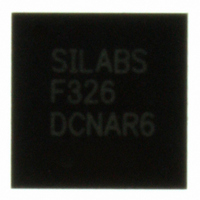C8051F326-GM Silicon Laboratories Inc, C8051F326-GM Datasheet - Page 98

C8051F326-GM
Manufacturer Part Number
C8051F326-GM
Description
IC 8051 MCU FLASH 16K 28QFN
Manufacturer
Silicon Laboratories Inc
Series
C8051F32xr
Specifications of C8051F326-GM
Program Memory Type
FLASH
Program Memory Size
16KB (16K x 8)
Package / Case
28-QFN
Core Processor
8051
Core Size
8-Bit
Speed
25MHz
Connectivity
UART/USART, USB
Peripherals
POR
Number Of I /o
15
Ram Size
1.5K x 8
Voltage - Supply (vcc/vdd)
2.7 V ~ 3.6 V
Oscillator Type
Internal
Operating Temperature
-40°C ~ 85°C
Processor Series
C8051F3x
Core
8051
Data Bus Width
8 bit
Data Ram Size
1.5 KB
Interface Type
UART/USB
Maximum Clock Frequency
25 MHz
Number Of Programmable I/os
15
Number Of Timers
2
Operating Supply Voltage
2.7 V to 3.6 V
Maximum Operating Temperature
+ 85 C
Mounting Style
SMD/SMT
3rd Party Development Tools
PK51, CA51, A51, ULINK2
Development Tools By Supplier
C8051F320DK
Minimum Operating Temperature
- 40 C
No. Of I/o's
15
Ram Memory Size
1280Byte
Cpu Speed
25MHz
No. Of Timers
2
Digital Ic Case Style
QFN
Supply Voltage
RoHS Compliant
Package
28QFN EP
Device Core
8051
Family Name
C8051F326
Maximum Speed
25 MHz
Lead Free Status / RoHS Status
Lead free / RoHS Compliant
For Use With
770-1006 - ISP 4PORT FOR SILABS C8051F MCU336-1450 - ADAPTER PROGRAM TOOLSTICK F326336-1306 - KIT DEV FOR C8051F326/7
Eeprom Size
-
Data Converters
-
Lead Free Status / Rohs Status
Lead free / RoHS Compliant
Other names
336-1296-5
Available stocks
Company
Part Number
Manufacturer
Quantity
Price
Company:
Part Number:
C8051F326-GM
Manufacturer:
SiliconL
Quantity:
811
Part Number:
C8051F326-GMR
Manufacturer:
SILICON LABS/芯科
Quantity:
20 000
C8051F326/7
12.7. Function Configuration and Control
The USB register POWER (Figure 12.8) is used to configure and control USB0 at the device level (enable/
disable, Reset/Suspend/Resume handling, etc.).
USB Reset: The USBRST bit (POWER.3) is set to ‘1’ by hardware when Reset signaling is detected on
the bus. Upon this detection, the following occur:
Writing a ‘1’ to the USBRST bit will generate an asynchronous USB0 reset. All USB registers are reset to
their default values following this asynchronous reset.
Suspend Mode: With Suspend Detection enabled (SUSEN = ‘1’), USB0 will enter Suspend Mode when
Suspend signaling is detected on the bus. An interrupt will be generated if enabled (SUSINTE = ‘1’). The
Suspend Interrupt Service Routine (ISR) should perform application-specific configuration tasks such as
disabling appropriate peripherals and/or configuring clock sources for low power modes. See Section
“10. Oscillators” on page 71 for more details on internal oscillator configuration, including the Suspend
mode feature of the internal oscillator.
USB0 exits Suspend mode when any of the following occur: (1) Resume signaling is detected or gener-
ated, (2) Reset signaling is detected, or (3) a device or USB reset occurs. If suspended, the internal oscil-
lator will exit Suspend mode upon any of the above listed events.
Resume Signaling: USB0 will exit Suspend mode if Resume signaling is detected on the bus. A Resume
interrupt will be generated upon detection if enabled (RESINTE = ‘1’). Software may force a Remote
Wakeup by writing ‘1’ to the RESUME bit (POWER.2). When forcing a Remote Wakeup, software should
write RESUME = ‘0’ to end Resume signaling 10-15 ms after the Remote Wakeup is initiated (RESUME =
‘1’).
ISO Update: When software writes ‘1’ to the ISOUP bit (POWER.7), the ISO Update function is enabled.
With ISO Update enabled, new packets written to an ISO IN endpoint will not be transmitted until a new
Start-Of-Frame (SOF) is received. If the ISO IN endpoint receives an IN token before a SOF, USB0 will
transmit a zero-length packet. When ISOUP = ‘1’, ISO Update is enabled for all ISO endpoints.
USB Enable: USB0 is disabled following a Power-On-Reset (POR). USB0 is enabled by clearing the
USBINH bit (POWER.4). Once written to ‘0’, the USBINH can only be set to ‘1’ by one of the following: (1)
a Power-On-Reset (POR), or (2) an asynchronous USB0 reset generated by writing ‘1’ to the USBRST bit
(POWER.3).
Software should perform all USB0 configuration before enabling USB0. The configuration sequence
should be performed as follows:
98
1.
2.
3.
4.
5.
6.
Step 1. Select and enable the USB clock source.
Step 2. Reset USB0 by writing USBRST= ‘1’.
Step 3. Configure and enable the USB Transceiver.
Step 4. Perform any USB0 function configuration (interrupts, Suspend detect).
Step 5. Enable USB0 by writing USBINH = ‘0’.
The USB0 Address is reset (FADDR = 0x00).
Endpoint FIFOs are flushed.
Control/status registers are reset to 0x00 (E0CSR, EINCSRL, EINCSRH, EOUTCSRL, EOUTCSRH).
USB register INDEX is reset to 0x00.
All USB interrupts (excluding the Suspend interrupt) are enabled and their corresponding flags cleared.
A USB Reset interrupt is generated if enabled.
Rev. 1.1











